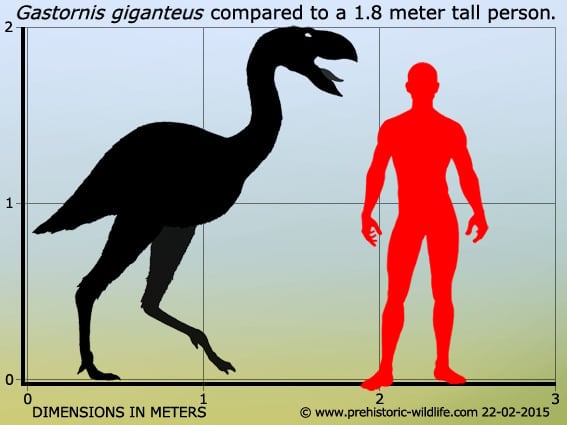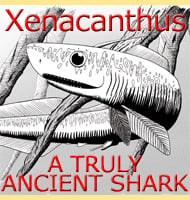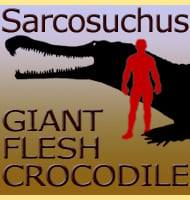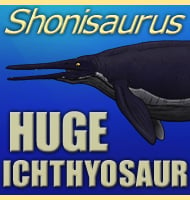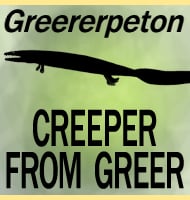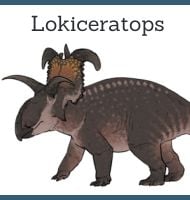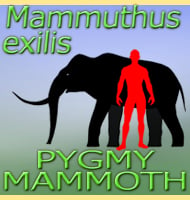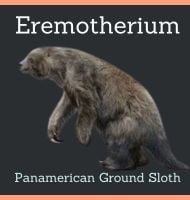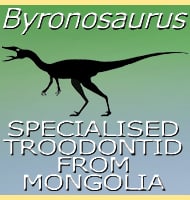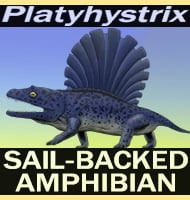In Depth
History and classification of Gastornis
Gastornis was first named as a genus in 1855 by E. H�bert. Gastornis means ‘Gaston’s bird’, and H�bert chose this name to honour Gaston Plant�, the man who discovered the first ever (and hence holotype) fossils of Gastornis in the French Argile Plastique Formation that is not far from Paris. This location was in turn the inspiration of the type species name G. parisiensis, which simply means ‘from Paris’.
Further fossils were found in the 1860s and 1870s, but early reconstructions of Gastornis were quite some way out from what we know today, and this is mainly due to the first reconstructions being composites of fossils of different animals. This also led to Gastornis being depicted as more of a crane-like bird with a very slender neck and narrow skull. However the actual skull of Gastornis had not been found save for a few scant fragments, and this crane-like skull was the perceived ‘ideal’ by a man named Lemoine.
At this time and on the other side of the Atlantic in the United States of America, the paleontological community was in the midst of the ‘bone wars’, a fierce rivalry between two naturalists named Edward Drinker Cope and Othniel Charles Marsh who were desperately trying to outdo one another. In 1874 Cope named a new fossil bird that he called Diatryma. Diatryma was a huge flightless bird of considerable size, though much of the skeleton and skull was still missing. In 1894, Marsh named a new genus based upon just a toe bone called Barornis, though by 1911 it is was declared to be synonymous with Diatryma. Very early in the twentieth century, several individuals of Diatryma, including almost complete skulls and skeletons had been found, not only in the United States, but in Europe also, and this would be the beginning of questions about the validity of Diatryma.
A similarity between Diatryma and Gastornis was noted as early as 1884 by the American Elliot Coues, and from this point and throughout most of the twentieth century a fairly quiet but long running debate about if Diatryma and Gastornis were one and the same continued to run. The main sticking point for both supporters and opponents to the theory was that the reconstruction of Gastornis by Lemoine did not look like Diatryma. However, in 1980 the truth about Lemoine’s reconstruction being a composite was realised for the first time, and when known fossils of Gastornis were carefully compared to those of Diatryma there was no doubt about the result: Diatryma was the same bird as Gastornis. Because the name Gastornis was registered some nineteen years before Cope named Diatryma, and no special case could be argued to preserve Diatryma (as what happened for Tyrannosaurus), all Diatryma fossils whether they were from North America or Europe became known as fossils of Gastornis.
In 1980 a new genus of bird based upon a foot bone from Henan Province in China was named as Zhongyuanus xichuanensis. However in 2013 this genus was renamed as a new species of Gastornis, G. xichuanensis.
Gastornis is now the type genus of a group of birds called the Gastornithidae, but what surprises many people is the fact the Gastornithidae is usually placed within a larger group called the Anseriformes which includes modern birds such as ducks, geese and swans. The gastornithids are distant relatives of the dromornithids, which include very large flightless birds that used to live in Australia. There does not seem to be any link direct link between gastornithids and phorusrhacids (better known as the South American ’terror birds’), though there has been some speculation that one phorusrhacid named Brontornis may actually be a gastornithid.Gastornis the bird
Gastornis was a very large flightless bird, with the largest species such as G. giganteus easily reaching heights of two meters. The legs were well developed with a stride that could cover a lot of ground allowing Gastornis to reach quite fast speeds. The wings by contrast were so underdeveloped that they were what is known as vestigial, present, but serving no practical physical purpose. However the vestigial wings may have still served a display purpose, especially if a different colour or type of plumage grew from them. As far as feathers go, Gastornis is usually recreated with hair-like feathers that would have been more for insulation and waterproofing during rainfall. This analysis was based upon early feathers attributed to Diatryma, but were later found to be plant fibres. A second feather that might belong to Gastornis however has now been identified, and this is a vaned feather similar to the body feathers that are commonly seen on flight capable birds. Again, other different feather types, particularly those for display may have grown upon different areas, but no clear remains exist at the time of writing.
When it was still known as Diatryma, Gastornis was one of the best represented prehistoric birds in popular science books about prehistoric animals. Usually this bird would be depicted as a terrible predator that chased after primitive horses such as Hyracotherium, killing them with their beaks. However this interpretation is now not only seen to be antiquated but just plain wrong by most researchers.
Gastornis had a large and robust beak and when the musculature is reconstructed it is clear that Gastornis would have been capable of an exceptionally strong bite. This was once the only evidence that people needed to suggest that Gastornis was a predator because the strength of the beak was far beyond that necessary for an herbivorous diet. However the beak of Gastornis is also notable for not having a hooked tip, a feature that is common in meat eating birds as it greatly helps to hook into and tear off strips of flesh in the absence of teeth. The feet of Gastornis are also noted as not having curved talons which could hook into and tear into bodies, another feature commonly seen in meat eating birds, but again absent in Gastornis.
One of the most conclusive studies concerning the diet of Gastornis was published in 2014 (Angst et al) and was focused upon the analysis of calcium isotopes preserved in the fossils of Gastornis. These isotopes clearly indicate that the Gastornis fossils tested all came from herbivores (plant eaters) and not carnivores (meat eaters). Because of this Gastornis is now perceived to be mostly if not exclusively herbivorous and using its powerful beak to shear through tough vegetation.
As a genus Gastornis is known to have existed for many millions of years and with fossils known from Europe, Asia and North America, there is no doubt that Gastornis was one of the most successful of the large flightless birds that once roamed the planet.
Further Reading
- Annonce de la d�couverte d’un oiseau fossile de taille gigantesque, trouv� � la partie inf�rieure de l’argile plastique des terrains parisiens [“Announcement of the discovery of a fossil bird of gigantic size, found in the lower Argile Plastique formation of the Paris region”]. - C. R. Hebd. Academy Sciiences Paris (in French) 40: 554–557. - 1855. - Note sur le tibia du Gastornis pariensis [sic] [Note on the tibia of Gastornis parisiensis]. - C. R. Hebd. Academy of Sciences Paris 40: 579–582. E. H�bert - 1855a. - Note sur le femur du Gastornis pariensis [sic] [Note on the femur of Gastornis parisiensis]. - C. R. Hebd. Academy of Sciences Paris 40: 579–582. E. H�bert - 1855b. - On a gigantic bird from the Eocene of New Mexico. - Proceedings of the Academy of Natural Sciences of Philadelphia 28 (2): 10–11. - Edward Drinker Cope - 1876. - Recherches sur les oiseaux fossiles des terrains tertiaires inf�rieurs des environs de Reims 2. - Matot-Braine, Reims. pp. 75–170. - V. Lemoine - 1881a. - Sur le Gastornis Edwardsii et le Remiornis Heberti de l’�oc�ne inf�rieur des environs de Reims [“On G. edwardsii and R. heberti from the Lower Eocene of the Reims area”]. - C. R. Hebd. Acad. Sci. Paris (in French) 93: 1157–1159. - V. Lemoine - 1881b. - The skeleton of Diatryma, a gigantic bird from the Lower Eocene of Wyoming. - Buletin of the American Museum of Natural History, 37(11): 307-354. - W. D. Matthew, W. Granger & W. Stein - 1917. - The Supposed Plumage of the Eocene Bird Diatryma. - American Museum Novitates 62: 1–4. - Theodore Dru Alison Cockerell - 1923. - Omorhamphus, a New Flightless Bird from the Lower Eocene of Wyoming. - Proceedings of the American Philosophical Society. LXVII (1): 51–65. - W. J. Sinclair - 1928. - Fossil Bird Remains from the Eocene of Wyoming. - Condor 35 (3): 115–118. - Alexander Wetmore - 1933. - New form of the Gastornithidae from the Lower Eocene of the Xichuan, Honan. - Vertebrata Palasiatica 18: 111-115. - L. Hou - 1980. - Biomechanics of the jaw apparatus of the gigantic Eocene bird Diatryma: Implications for diet and mode of life. - Paleobiology 17 (2): 95–120. - Lawrence Witmer & Kenneth Rose - 1991. - The status of the Late Paleocene birds Gastornis and Remiornis. - Los Angeles: Natural History Museum of Los Angeles County (Sciences series) 36:97-108. - L. D. Martin - 1992. - Reappraisal of the Eocene groundbird Diatryma (Aves: Anserimorphae). - Papers in avian paleontology honoring Pierce Brodkorb–Natural History Museum of Los Angeles County Science Series 36: 109–125. - Allison Andors - 1992. - The status of the Late Paleocene birds Gastornis and Remiornis. - Papers in Avian Paleontology honoring Pierce Brodkorb. Natural History Museum of Los Angeles County, Science Series, 36: 97-108. - L. D. Martin - 1992. - New remains of the giant bird Gastornis from the Upper Paleocene of the eastern Paris Basin and the relationships between Gastornis and Diatryma. - N. Jb. Geol. Pal�ont. Mh., (3): 179-190. - E. Buffetaut - 1997. - Footprints of Giant Birds from the Upper Eocene of the Paris Basin: An Ichnological Enigma. - Ichnos 11 (3–4): 357–362. - Eric Buffetaut - 2004. - Giant Eocene Bird Footprints From Northwest Washington, USA. - Palaeontology 55 (6): 1293–1305. - George E. Mustoe, David S. Tucker & Keith L. Kemplin - 2012. - The giant bird Gastornis in Asia: A revision of Zhongyuanus xichuanensis Hou, 1980, from the Early Eocene of China. - Paleontological Journal, 47(11): 1302-1307. - E. Buffetaut - 2013. - Reappraisal of the bone inventory of Gastornis geiselensis (Fischer, 1978) from the Eocene Geiseltal Fossillagerstatte (Saxony-Anhalt, Germany). - Neues Jahrbuch f�r Geologie und Pal�ontologie-Abhandlungen, 269(2): 203-220. - M. Hullmund - 2013. - Isotopic and anatomical evidence of an herbivorous diet in the Early Tertiary giant bird Gastornis. Implications for the structure of Paleocene terrestrial ecosystems. - Naturwissenschaften - D. Angst, C. L�cuyer, R. Amiot, E. Buffetaut, F. Fourel, F. Martineau, S. Legendre, A. Abourachid & A. Herrel - 2014. – Description of a new species of Gastornis (Aves, Gastornithiformes) from the early Eocene of La Borie, southwestern France. – Geobios. 63: 39–46. – C�cile Mourer-Chauvir� & Estelle Bourdon – 2020.
